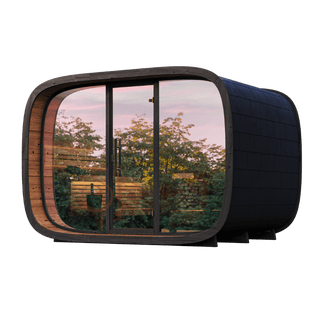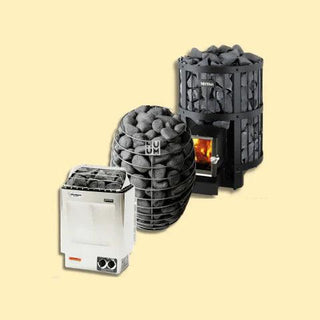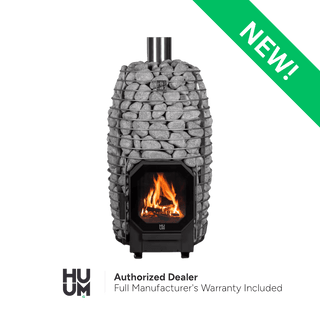Sauna Stoves
Transform your sauna into a place of ancient tranquility with a wood-burning sauna stove. The gentle heat of the stove, coupled with the natural aroma of burning wood, guarantees a wonderfully relaxing and authentic sauna experience.
As the nation's number one source for sauna stoves, we take pride in offering trusted wood sauna stove brands like Harvia, Finlandia, HUUM, Saunacore, Saunum, and Scandia. Our selection of wood-burning sauna heaters is designed to provide even heat and superior circulation, creating a sauna environment that is both stylish and fundamentally traditional at its roots.
Filter
Harvia M3 Wood Burning Sauna Stove
Regular price
$908.00
$818.00
$90.00 off
- Unit price
- / per
Regular price
$908.00
$818.00
$90.00 off
- Unit price
- / per
In stock
Harvia Legend 240 Wood Burning Sauna Stove
$1,765.00
- Unit price
- / per
$1,765.00
- Unit price
- / per
Out of stock
HUUM HIVE Flow Mini Wood Burning Sauna Stove
$2,344.00
- Unit price
- / per
$2,344.00
- Unit price
- / per
In stock
Harvia 20 DUO Wood Burning Sauna Stove
Regular price
$2,693.00
$2,424.00
$269.00 off
- Unit price
- / per
Regular price
$2,693.00
$2,424.00
$269.00 off
- Unit price
- / per
In stock
Harvia 20 Pro Wood Burning Sauna Stove
Regular price
$1,462.00
$1,316.00
$146.00 off
- Unit price
- / per
Regular price
$1,462.00
$1,316.00
$146.00 off
- Unit price
- / per
In stock
HUUM Hive Wood 13 Wood Burning Sauna Stove
$1,739.00
- Unit price
- / per
$1,739.00
- Unit price
- / per
In stock
Harvia Legend 150SL Wood Burning Sauna Stove
Regular price
$2,056.00
$1,851.00
$205.00 off
- Unit price
- / per
Regular price
$2,056.00
$1,851.00
$205.00 off
- Unit price
- / per
In stock
HUUM HIVE Flow LS Wood Burning Sauna Stove
$2,605.00
- Unit price
- / per
$2,605.00
- Unit price
- / per
In stock
HUUM HIVE Flow Wood Burning Sauna Stove
$2,531.00
- Unit price
- / per
$2,531.00
- Unit price
- / per
In stock
Harvia Legend 300 Wood Burning Sauna Stove
Regular price
$3,510.00
$3,159.00
$351.00 off
- Unit price
- / per
Regular price
$3,510.00
$3,159.00
$351.00 off
- Unit price
- / per
In stock
Harvia Linear 16 Wood Burning Sauna Stove
Regular price
$901.00
$811.00
$90.00 off
- Unit price
- / per
Regular price
$901.00
$811.00
$90.00 off
- Unit price
- / per
In stock
Harvia 20 SL Wood Burning Sauna Stove
Regular price
$1,672.00
$1,504.00
$168.00 off
- Unit price
- / per
Regular price
$1,672.00
$1,504.00
$168.00 off
- Unit price
- / per
In stock
Harvia 36 Pro Wood Burning Sauna Stove
Regular price
$2,218.00
$1,996.00
$222.00 off
- Unit price
- / per
Regular price
$2,218.00
$1,996.00
$222.00 off
- Unit price
- / per
In stock
Harvia Legend 240 Greenflame Wood Burning Sauna Stove
Regular price
$2,682.00
$2,414.00
$268.00 off
- Unit price
- / per
Regular price
$2,682.00
$2,414.00
$268.00 off
- Unit price
- / per
In stock
Harvia Legend 150 Wood Burning Sauna Stove
Regular price
$1,960.00
$1,764.00
$196.00 off
- Unit price
- / per
Regular price
$1,960.00
$1,764.00
$196.00 off
- Unit price
- / per
In stock
Harvia M3SL Wood Burning Sauna Stove
Regular price
$1,328.00
$1,195.00
$133.00 off
- Unit price
- / per
Regular price
$1,328.00
$1,195.00
$133.00 off
- Unit price
- / per
In stock
HUUM Hive Wood 17 LS Wood Burning Sauna Stove
$2,334.00
- Unit price
- / per
$2,334.00
- Unit price
- / per
In stock
Harvia 50 SL Black Wood Burning Sauna Heater
Regular price
$7,539.00
$6,785.00
$754.00 off
- Unit price
- / per
Regular price
$7,539.00
$6,785.00
$754.00 off
- Unit price
- / per
In stock
Pre-order
Harvia Linear 18 Compact Black Wood Burning Sauna Heater
Regular price
$1,610.00
$1,449.00
$161.00 off
- Unit price
- / per
Regular price
$1,610.00
$1,449.00
$161.00 off
- Unit price
- / per
In stock
Pre-order
Harvia Linear 22 Greenflame Black Wood Burning Sauna Stove
Regular price
$2,311.00
$2,080.00
$231.00 off
- Unit price
- / per
Regular price
$2,311.00
$2,080.00
$231.00 off
- Unit price
- / per
In stock
Pre-order
Harvia Linear 22 Greenflame Black Wood Burning Sauna Stove
Regular price
$1,438.00
$1,295.00
$143.00 off
- Unit price
- / per
Regular price
$1,438.00
$1,295.00
$143.00 off
- Unit price
- / per
In stock
Pre-order
Harvia Pro 20 RS Black Wood Burning Sauna Heater
Regular price
$2,080.00
$1,872.00
$208.00 off
- Unit price
- / per
Regular price
$2,080.00
$1,872.00
$208.00 off
- Unit price
- / per
In stock
Pre-order
Harvia PRO 20 LS Black Wood Burning Sauna Heater
Regular price
$2,080.00
$1,872.00
$208.00 off
- Unit price
- / per
Regular price
$2,080.00
$1,872.00
$208.00 off
- Unit price
- / per
In stock
Pre-order
HUUM HIVE Flow Mini LS Wood Burning Sauna Stove
$2,433.00
- Unit price
- / per
$2,433.00
- Unit price
- / per
In stock
Harvia 36 DUO Wood Burning Sauna Stove
Regular price
$3,204.00
$2,883.00
$321.00 off
- Unit price
- / per
Regular price
$3,204.00
$2,883.00
$321.00 off
- Unit price
- / per
In stock
Harvia 50 Wood Burning Sauna Stove
Regular price
$7,117.00
$6,405.00
$712.00 off
- Unit price
- / per
Regular price
$7,117.00
$6,405.00
$712.00 off
- Unit price
- / per
In stock
Harvia Legend 300DUO Wood Burning Sauna Stove
Regular price
$3,585.00
$3,227.00
$358.00 off
- Unit price
- / per
Regular price
$3,585.00
$3,227.00
$358.00 off
- Unit price
- / per
In stock
Harvia Linear 22LS Greenflame Wood Burning Sauna Stove
Regular price
$2,311.00
$2,080.00
$231.00 off
- Unit price
- / per
Regular price
$2,311.00
$2,080.00
$231.00 off
- Unit price
- / per
In stock
- 1
- 2
You're viewing 1-28 of 37 products








































